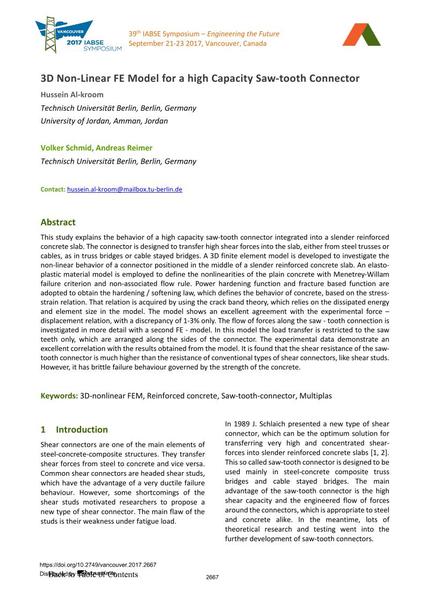3D Non-Linear FE Model for a high Capacity Saw-tooth Connector

|
|
|||||||||||
Bibliografische Angaben
| Autor(en): |
Hussein Al-Kroom
(Technisch Universität Berlin, Berlin, Germany University of Jordan, Amman, Jordan)
Volker Schmid (Technisch Universität Berlin, Berlin, Germany) Andreas Reimer (Technisch Universität Berlin, Berlin, Germany) |
||||
|---|---|---|---|---|---|
| Medium: | Tagungsbeitrag | ||||
| Sprache(n): | Englisch | ||||
| Tagung: | IABSE Symposium: Engineering the Future, Vancouver, Canada, 21-23 September 2017 | ||||
| Veröffentlicht in: | IABSE Symposium Vancouver 2017 | ||||
|
|||||
| Seite(n): | 2667-2674 | ||||
| Anzahl der Seiten (im PDF): | 8 | ||||
| Jahr: | 2017 | ||||
| DOI: | 10.2749/vancouver.2017.2667 | ||||
| Abstrakt: |
This study explains the behavior of a high capacity saw-tooth connector integrated into a slender reinforced concrete slab. The connector is designed to transfer high shear forces into the slab, either from steel trusses or cables, as in truss bridges or cable stayed bridges. A 3D finite element model is developed to investigate the non-linear behavior of a connector positioned in the middle of a slender reinforced concrete slab. An elasto- plastic material model is employed to define the nonlinearities of the plain concrete with Menetrey-Willam failure criterion and non-associated flow rule. Power hardening function and fracture based function are adopted to obtain the hardening / softening law, which defines the behavior of concrete, based on the stress- strain relation. That relation is acquired by using the crack band theory, which relies on the dissipated energy and element size in the model. The model shows an excellent agreement with the experimental force – displacement relation, with a discrepancy of 1-3% only. The flow of forces along the saw - tooth connection is investigated in more detail with a second FE - model. In this model the load transfer is restricted to the saw teeth only, which are arranged along the sides of the connector. The experimental data demonstrate an excellent correlation with the results obtained from the model. It is found that the shear resistance of the saw- tooth connector is much higher than the resistance of conventional types of shear connectors, like shear studs. However, it has brittle failure behaviour governed by the strength of the concrete. |
||||
| Stichwörter: |
Stahlbeton
|
||||
